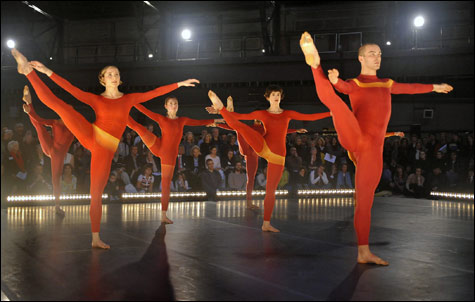
NO EULOGIES FOR MERCE: The mood was upbeat; the crowd milled around the three stages, creating a performance of its own. |
“A dancer has to find a way to begin again each day. . . . It’s about how do you continue rather than simply stopping.” — Merce Cunningham
NEW YORK — If you wanted to know what happened at the Merce Cunningham memorial a week ago Wednesday in the Park Avenue Armory, you could get a thousand answers. Every person in the audience must have experienced the event differently. Cunningham would have approved.
Early in his career, Cunningham, who died in July, at age 90, devised a format he called “Events” to allow his company to perform choreography in fields, gymnasiums, plazas — those often-unsuitable spaces that a company sometimes confronts on tour. He figured it was better to show audiences the dancing, even if he had to forgo the original stage designs or movable pieces of scenery, or the music that went with them. The performance could be shaped to suit each particular location. He didn’t have to show whole dances at all; sections of old ones and newer ones could be stitched and layered together and performed without interruption.
“Events” became a reliable component of the Cunningham company’s touring package. By now they total somewhere around 800. Wednesday’s tribute was the grandest of them all. Far more than a formal concert would have done, it not only showcased Cunningham dancing, it validated his lifelong belief in the possibilities of the chance encounter.
Three moderate-size stage spaces were laid out on the vast floor of the Armory, which occupies half a city block. The stage lighting came from small striplights bordering the dance floors and some spotlights on the balcony. In a continual stream, from 4:30 till about 8:30, excerpts from dances and technique exercises were shown by 14 members of the Cunningham Dance Company, four members of the Repertory Understudy Group, nearly 30 former Cunningham dancers, youngsters from nine public and private schools, and a battalion of musicians.
A printed schedule charted who was performing which piece on which stage, but the segments could be as brief as five minutes, and the performances often overlapped. No way to see everything. You’d wriggle through a crowd or stand on tiptoe to catch alumnus Neil Greenberg (1980–1986) jumping exultantly in choreography that had probably been made for him, in Doubles and Roaratorio. Or Holley Farmer (1997–2009) making an entrance like a queen in a chic evening dress and swanning through five minutes of Fluid Canvas, a dance I never saw. Or a bunch of former company members centering, posing a minute at a time, changing on a signal, for John Cage’s 4’33”.
To begin the evening, the company, distributed among the three stages and moving between them, danced Second Hand (1970) to a recording of Cage playing his Cheap Imitation, an imitation of Erik Satie’s Socrate. This dance may have had personal overtones. Cunningham always covered up his sources, and I often suspected the dances were not as objective as the chance operations by which they were made. At the Armory, Robert Swinston danced Cunningham’s part, solemnly patrolling the edges of Space #2, sometimes joining the younger dancers, but always a little aloof from their airborne elasticity.